

Angra Mainyu. In the Avesta[edit] In Zoroaster's revelation[edit] Avestan angra mainyu "seems to have been an original conception of Zoroaster's.
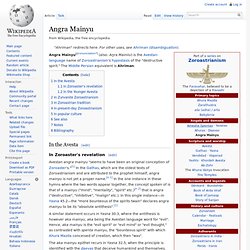
Azrael. Background[edit]
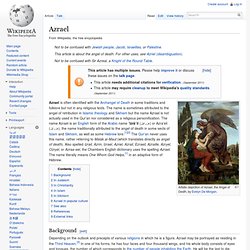
Ereshkigal. In Mesopotamian mythology, Ereshkigal (𒀭𒊩𒆠𒃲 DEREŠ.KI.GAL, lit.
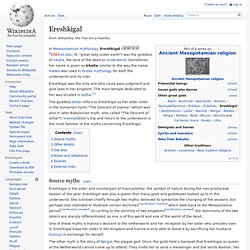
"great lady under earth") was the goddess of Irkalla, the land of the dead or underworld. Sometimes her name is given as Irkalla, similar to the way the name Hades was used in Greek mythology for both the underworld and its ruler. Ereshkigal was the only one who could pass judgment and give laws in her kingdom. The main temple dedicated to her was located in Kutha.[1] Erlik. Erlik or Erlig, (in Hungarian mythology equivalent to Ördög) is the god of death and underworld in Turkic and Mongolian mythology.

Features[edit] According to Siberian mythology, Erlik was the first creation of Tengri or Ulgan, the creator god, but Erlik's pride led to friction between the two, and he was banished to the underworld. In the myths of the Turko-Mongol peoples, Erlik was involved in the creation of humanity.[1] He slew the messenger-god, Maidere, and is a teacher of sin. He is sometimes represented by a totemic bear. Izanami-no-Mikoto. Searching the Seas with the Tenkei(天瓊を以て滄海を探るの図, Tenkei o motte sōkai o saguru no zu?).
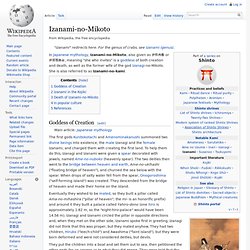
Painting by Kobayashi Eitaku, 1880-90 (MFA, Boston). Izanagi to the right, Izanami to the left. In Japanese mythology, Izanami-no-Mikoto, also given as 伊弉冉尊 or 伊邪那美命, meaning "she who invites" is a goddess of both creation and death, as well as the former wife of the god Izanagi-no-Mikoto. She is also referred to as Izanami-no-kami. Goddess of Creation[edit] The first gods Kunitokotachi and Amenominakanushi summoned two divine beings into existence, the male Izanagi and the female Izanami, and charged them with creating the first land. Eventually they wished to be mated, so they built a pillar called Ama-no-mihashira ("pillar of heaven"; the mi- is an honorific prefix) and around it they built a palace called Yahiro-dono (one hiro is approximately 1.82 m, so the "eight-hiro-palace" would have been 14.56 m). Mara (Hindu goddess) Mara is a Hindu goddess of death.

Mot (Semitic god) That you not come near to divine Death,lest he made you like a lamb in his mouth, (and) you both be carried away like a kid in the breach of his windpipe.
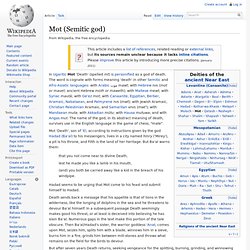
Hadad seems to be urging that Mot come to his feast and submit himself to Hadad. Death sends back a message that his appetite is that of lions in the wilderness, like the longing of dolphins in the sea and he threatens to devour Ba‘al himself. In a subsequent passage Death seemingly makes good his threat, or at least is deceived into believing he has slain Ba‘al.
Numerous gaps in the text make this portion of the tale obscure. Then Ba‘al/Hadad's sister, the warrior goddess ‘Anat, comes upon Mot, seizes him, splits him with a blade, winnows him in a sieve, burns him in a fire, grinds him between mill-stones and throws what remains on the field for the birds to devour. But after seven years Death returns, seeking vengeance for the splitting, burning, grinding, and winnowing and demanding one of Ba‘al's brothers to feed upon. Nergal. The name Nergal, Nirgal, or Nirgali (Hebrew: נֵרְגַל, Modern Nergal Tiberian Nērḡál; Aramaic ܢܹܪܓܵܐܠ; Latin: Nergel) refers to a deity worshipped throughout Mesopotamia (Akkad, Assyria and Babylonia) with the main seat of his cult at Cuthah represented by the mound of Tell-Ibrahim.
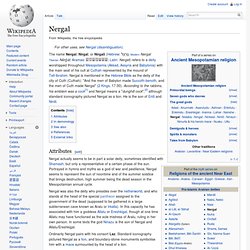
Ox-Head and Horse-Face. In the Chinese classic novel Journey to the West, at one point Horse-Faces and Ox-Heads are sent to capture Sun Wukong, the Monkey King.

Sun Wukong overpowers them and scares them away. Shinigami. Shinigami in Japanese religion[edit] "Depiction of Searching in the Blue Sea by Amanonu (天瓊を以て滄海を探るの図)" by Eitaku Kobayashi.
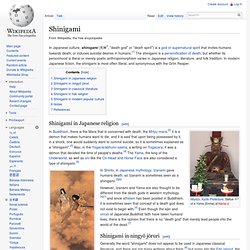
Izanami is to the left. In Shinto, in Japanese mythology, Izanami gave humans death, so Izanami is sometimes seen as a shinigami.[5][6] However, Izanami and Yama are also thought to be different from the death gods in western mythology,[4][7] and since atheism has been posited in Buddhism, it is sometimes seen that concept of a death god does not exist to begin with.[4] Even though the kijin and onryō of Japanese Buddhist faith have taken humans' lives, there is the opinion that there is no "death god" that merely lead people into the world of the dead.[7] Shinigami in ningyō jōruri[edit]
Yama (Hinduism) "Dharma (Hinduism)" redirects here. Yama. Yama's Court and Hell. The Blue figure is Yama with his consort Yami and Chitragupta. A 17th-century painting from the Government Museum in Chennai. Hinduism[edit] Yamaduta.